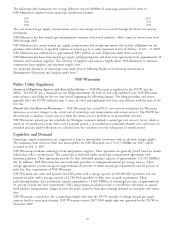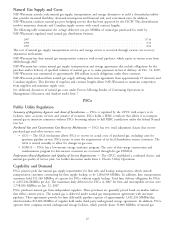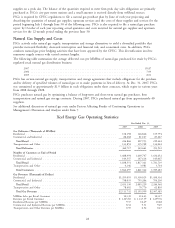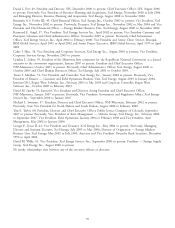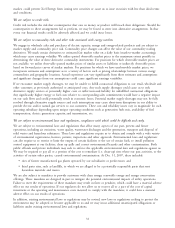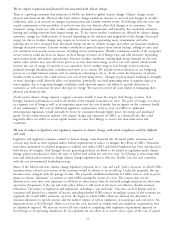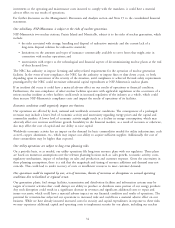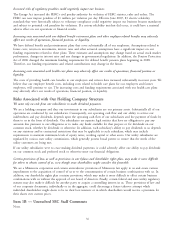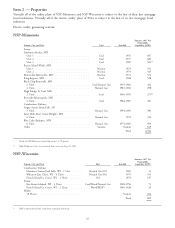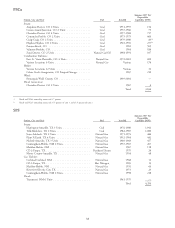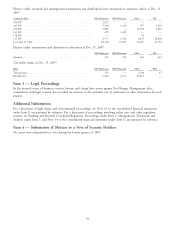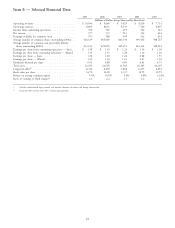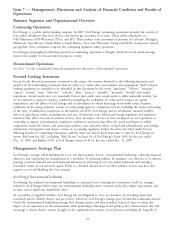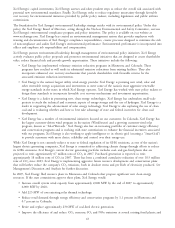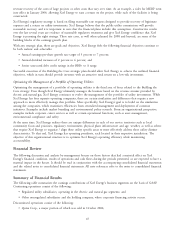Xcel Energy 2007 Annual Report Download - page 45
Download and view the complete annual report
Please find page 45 of the 2007 Xcel Energy annual report below. You can navigate through the pages in the report by either clicking on the pages listed below, or by using the keyword search tool below to find specific information within the annual report.power plants under the NRC’s design basis threat requirements, such as additional physical plant security and additional
security personnel.
The insurance industry has also been affected by these events and the availability of insurance covering risks we and our
competitors typically insure against may decrease. In addition, the insurance we are able to obtain may have higher
deductibles, higher premiums and more restrictive policy terms.
A disruption of the regional electric transmission grid, interstate natural gas pipeline infrastructure or other fuel sources,
could negatively impact our business. Because our generation, transmission systems, and local natural gas distribution
companies are part of an interconnected system, we face the risk of possible loss of business due to a disruption caused
by an event (severe storm, severe temperature extremes, generator or transmission facility outage, pipeline rupture,
railroad disruption, sudden and significant increase or decrease in wind generation) within our operating systems or on
a neighboring system or the actions of a neighboring utility. Any such disruption could result in a significant decrease
in revenues and significant additional costs to repair assets, which could have a material adverse impact on our financial
condition and results.
We are subject to business continuity risks associated with our ability to respond to unforeseen events.
Our response to unforeseen events will, in part, determine the financial impact of the event on our financial condition
and results. It’s difficult to predict the magnitude of such events and associated impacts.
We are subject to information security risks.
A security breach of our information systems could subject us to financial harm associated with theft or inappropriate
release of certain types of information, including, but not limited to, customer or system operating information. We are
unable to quantify the potential impact of such an event.
Rising energy prices could negatively impact our business.
Higher fuel costs could significantly impact our results of operations if requests for recovery are unsuccessful. In
addition, higher fuel costs could reduce customer demand or increase bad debt expense, which could also have a
material impact on our results of operations. Delays in the timing of the collection of fuel cost recoveries as compared
with expenditures for fuel purchases could have an impact on our cash flows. We are unable to predict future prices or
the ultimate impact of such prices on our results of operations or cash flows.
Our operating results may fluctuate on a seasonal and quarterly basis and can be adversely affected by milder weather.
Our electric and natural gas utility businesses are seasonal businesses and weather patterns can have a material impact
on our operating performance. Demand for electricity is often greater in the summer and winter months associated
with cooling and heating. Because natural gas is heavily used for residential and commercial heating, the demand for
this product depends heavily upon weather patterns throughout our service territory, and a significant amount of
natural gas revenues are recognized in the first and fourth quarters related to the heating season. Accordingly, our
operations have historically generated less revenues and income when weather conditions are milder in the winter and
cooler in the summer. Unusually mild winters and summers could have an adverse effect on our financial condition and
results of operations.
Our natural gas distribution activities involve numerous risks that may result in accidents and other operating risks and
costs.
There are inherent in our natural gas distribution activities a variety of hazards and operating risks, such as leaks,
explosions and mechanical problems, which could cause substantial financial losses. In addition, these risks could result
in loss of human life, significant damage to property, environmental pollution, impairment of our operations and
substantial losses to us. In accordance with customary industry practice, we maintain insurance against some, but not
all, of these risks and losses.
The occurrence of any of these events not fully covered by insurance could have a material adverse effect on our
financial position and results of operations. For our distribution lines located near populated areas, including residential
areas, commercial business centers, industrial sites and other public gathering areas, the level of damages resulting from
these risks is greater.
35



